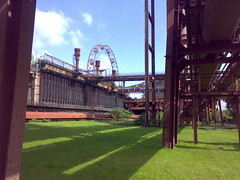My family comes from an industrial city called Karkkila. My grandfather worked at the factory, my father had a summerjob at the factory and the director of the Högfors steel factory was the most influential person in Karkkila. He kept the schools going, the public saunas warm and the tennis courts (for the upper class) clean.
I had not thought of this for years before yesterday when we visited the Zollverein, an old coal mine and a coking plant in the city of Essen in the West-German Ruhr area. Zollverein - with steel tycoons like the Krupp family - is currently being turned into one of the biggest cultural centres in our entire region as the factories have been closed gradually starting in the 1970s.
The area is massive and beautiful. The symmetric forms and clarity (form follows function) really pleases one's eye. The Ruhr area - with its notorious reputation as the place where you cannot see the blue sky because of the smoke and where you cannot swim in the river - won the bid for the European Capital of Culture in 2010 and is now transforming itself into something new and shiny.
The presentation of their plans was impressive. They plan to close the motorway for a streetparty, they are building islands on the rivers and doing a year-long cultural programme for the area of 54 cities. Their start was already good by snatching the Love Parade away from Berlin. The budget for 2010 activities is around 48 million euros - excluding the recontstruction costs like the ones at Zollverein.
The trip was the ECF's staff day and me and most of my colleagues were positively surprised after nagging on the bus about the destination. Even if Essen still has a long way to go in order to be a creative hub - starting from having at least one bar open in the centre after midnight -, their start is greatly impressive. Zollverein is an example of thinking long-term and big. And some of the elements like the bright orange staircase and escalator by the Dutch star designer Rem Koolhaas are just breathtakingly beautiful.
In 2000 I worked in a project that was part of Helsinki's European City of Culture programme. The best thing in that year was the way it allowed the citizens of Helsinki to love and be proud of their hometown. Helsinki suddenly became exciting, fun and lively.
Karkkila - my family's hometown - was long known as the Finnish city with the greatest debts, one of the heaviest unemployment rates and highest communal taxation. Karkkila still has a long way to go if it wishes to work its way out of this vicious cycle of mass emigration to Helsinki and companies shutting down their production plants.
The Ruhr area is up to similar challenges. one of the successes of the year could be a new dream for the area that has been for years the prime tragic example of the end of industrialisation.
MM11 Koulukirjojen hinnoittelu
1 day ago













No comments:
Post a Comment